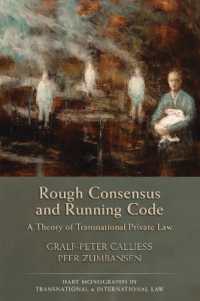- ホーム
- > 洋書
- > 英文書
- > History / World
Full Description
During the eighteenth century there was a growing interest in recording, listing and documenting the world, whether for personal interest and private consumption, or general record and the greater good. Such documentation was done through both the written and printed word. Each genre had its own material conventions and spawned industries which supported these practices. This volume considers writing and printing in parallel: it highlights the intersections between the two methods of communication; discusses the medium and materiality of the message; considers how writing and printing were deployed in the construction of personal and cultural identities; and explores the different dimensions surrounding the production, distribution and consumption of private and public letters, words and texts during the eighteenth-century. In combination the chapters in this volume consider how the processes of both writing and printing contributed to the creation of cultural identity and taste, assisted in the spread of knowledge and furthered personal, political, economic, social and cultural change in Britain and the wider-world. This volume provides an original narrative on the nature of communication and brings a fresh perspective on printing history, print culture and the literate society of the Enlightenment.
Contents
List of Illustrations
Acknowledgements
Introduction, Caroline Archer-Parré and Malcolm Dick
1. The Growth of Copperplate Script: Joseph Champion and The Universal Penman, Nicolas Barker
2. Authorship in script and print: the example of engraved handwriting manuals of the eighteenth century, Giles Bergel
3.Writing and the preservation of cultural identity: the penmanship manuals of Zaharija Orfelin, Persida Lazarević Di Giacomo
4. 'The most beautiful hand': John Byrom and the aesthetics of shorthand, Timothy Underhill
5. An Archaeology of the Letter Writing: the correspondence of aristocratic women in late eighteenth- and early nineteenth-century England, Ruth Larsen
6. Private pleasures and portable presses: do-it-yourself printers in the eighteenth-century, Caroline Archer-Parré
7. Performance and print culture: two eighteenth-century actresses and their image control, Joanna Jarvis
8. Script, print, and the public/private divide: Sir David Ochterlony's dying words, Callie Wilkinson
9. Identity, enigma, assemblage: John Baskerville's Vocabulary, or Pocket Dictionary, Lynda Muggleston
10. Marigolds not manufacturing: plants, print and commerce in eighteenth-century Birmingham, Elaine Mitchell
11. Tourist Experience and the Manufacturing Town: James Bisset's Magnificent Directory of Birmingham, Jenni Dixon
12. Forging an identity on the periphery of the Enlightenment: Malta in print in the eighteenth-century, Robert Thake
13. Perceptions of England: the production and reception of English theatrical publications in Germany and the Netherlands during the eighteenth century, Emil Rybczak
14. Print Culture and Distribution: Circulating the Federalist Papers in post-Revolutionary America, Peter Pellizzari
15. The serif-less letters of John Soane, Jon Melton
Notes on the Contributors
Index








